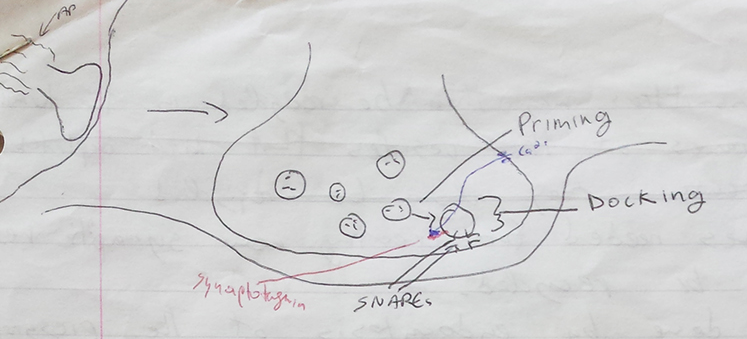How neurotransmission happens
12th July 2016
Synaptic vesicles in distinct pools – either on the cytoskeleton, or free in the cytoplasm. Free vesicles go towards the plasma membrane and dock, being prepared for exocytosis.
Priming is the preparation of the vesicular and the plasma membranes for fusion.
The two membranes are drawn close together by protein complexes names SNAREs that are expressed on both membranes.
Action potential -> Depolarisation -> this causes V.O.C.C.s to open and lets Ca2+ to rush in. Ca2+ ions bind to special proteins on the membrane of vesicles, called “Synaptotagmin”. Vesicles are drawn even closer to plasma membrane. This causes the membranes to fuse together, allowing the contents of the vesicle to be exocytosed to the synaptic cleft. Neurotransmitters bind to the receptors on the post-synaptic membrane.
Depending on the neurotransmitter and the receptors involved, the reaction of the post-synaptic neuron may be excitatory or inhibitory. In some cases, there are special enzymes found in the synaptic cleft that breakdown the neurotransmitters. In other cases, the neurotransmitters are “cleared up” from the synaptic area by being “reuptaken”, i.e. taken up by special proteins on the pre-synaptic neurons called transporters. The neurotransmitters may then be recycled in the terminal.
The membranes needed for creating new synaptic vesicles may also be recycled.
This is done by endocytosis on the part of the pre-synaptic membrane.
New vesicles are created, are filled again with neurotransmitters, and prepare for another round of synaptic transmission.
Post-synaptic Response: This depends, as mentioned before, on the neurotransmitters and the receptors involved and also on the specific ions that will gain passage through the receptors. If this results in a depolarisation, then this will increase the excitability of the post-synaptic neuron. This is known as EPSP. If the response is a hyperpolarisation, then this will decrease the excitability of the neuron, or increase the inhibition, and this is called IPSP.

Action potential -> Depolarisation -> this causes V.O.C.C.s to open and lets Ca2+ to rush in. Ca2+ ions bind to special proteins on the membrane of vesicles, called “Synaptotagmin”. Vesicles are drawn even closer to plasma membrane. This causes the membranes to fuse together, allowing the contents of the vesicle to be exocytosed to the synaptic cleft. Neurotransmitters bind to the receptors on the post-synaptic membrane.
Depending on the neurotransmitter and the receptors involved, the reaction of the post-synaptic neuron may be excitatory or inhibitory. In some cases, there are special enzymes found in the synaptic cleft that breakdown the neurotransmitters. In other cases, the neurotransmitters are “cleared up” from the synaptic area by being “reuptaken”, i.e. taken up by special proteins on the pre-synaptic neurons called transporters. The neurotransmitters may then be recycled in the terminal.
The membranes needed for creating new synaptic vesicles may also be recycled.
This is done by endocytosis on the part of the pre-synaptic membrane.
New vesicles are created, are filled again with neurotransmitters, and prepare for another round of synaptic transmission.
Post-synaptic Response: This depends, as mentioned before, on the neurotransmitters and the receptors involved and also on the specific ions that will gain passage through the receptors. If this results in a depolarisation, then this will increase the excitability of the post-synaptic neuron. This is known as EPSP. If the response is a hyperpolarisation, then this will decrease the excitability of the neuron, or increase the inhibition, and this is called IPSP.





